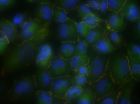(Press-News.org) Researchers at Uppsala University have, together with researchers from Turku and Bergen, discovered a new biomarker which makes it possible to identify women with uterine cancer who have a high risk of recurrence. The findings were recently published in the journal Gynecologic Oncology.
Endometrial cancer of the uterus is the most common form of gynecologic cancer in Europe and North America. The treatment primarily consists of removing the uterus and in some cases offering chemotherapy if the risk of recurrence is deemed high.
The current study looks at the amount of protein ASRGL1 present in the tumour cells in uterine cancer. Based on the amount of ASRGL1 the researchers were able to separate women with a negative prognosis and high risk of recurrence from the patients who fared better after their operation. The study was conducted in cooperation between researchers at the universities in Uppsala, Turku and Bergen and is based on samples collected from 500 women who were diagnosed with uterine cancer between the years 1981 and 2007.
The protein ASRGL1 is an enzyme that normally exists in healthy cells of the uterus. The current study shows that patients who had entierly or partially lost ASRGL1 in the tumour cells had a much higher risk of the cancer recurring and dying from the disease, while patients with sustained high levels of ASRGL1 had a much lower risk of recurrence. The study also shows that ASRGL1 is an independent prognostic factor, even after compensating for other risk factors such as tumour stage and tumour grade.
The researchers hope that analyses of ASRGL1 in time can become a diagnostic tool to identify those women who have a higher risk of recurrence and therefore need more extensive treatment.
'I view the results as a first step towards personal treatment of uterine cancer. Today, 10-15 per cent of the patients suffer recurrences, even though they were considered low risk patients according to classic diagnostics. By using ASRGL1, the chance of identifying such hidden high-risk patients and offer them more aggressive treatment after their operation increases', says Per-Henrik Edqvist, researcher at Uppsala University's Department of Immunology, Genetics and Pathology, and main author of the study.
Further studies are now being planned to investigate whether ASRGL1 also can be used for diagnosing tissue biopsies taken before the operation, to identify patients in need of more extensive surgery.
'Our results are promising, but more research is needed before ASRGL1 can be accepted as a new diagnostic tool in healthcare. But hopefully the process can be speeded up since Swedish biotech company Atlas Antibodies has shown interest in commercialising our findings', says Per-Henrik Edqvist.
The study is a result of the decade-long mapping of human proteins, The Human Protein Atlas project, which was published in the autumn 2014. It was within The Human Protein Atlas project that the expression of the ASRGL1 protein was first mapped in the human body's normal tissues and in different forms of cancer. By searches in the public protein atlas database the researchers were able to identify ASRGL1 as a potential new biomarker.
'The protein atlas project enabled our discovery and our study is an excellent example of how The Human Protein Atlas database can be used by researchers across the world to find interesting leads to follow up on', says Per-Henrik Edqvist.
INFORMATION:
For more information, please contact Per-Henrik Edqvist, +46 18 4714483, +46 73 5457760
per-henrik.edqvist@igp.uu.se
Edqvist et al (2015) Loss of ASRGL1 expression is an independent biomarker for disease-specific survival in endometrioid endometrial carcinoma, Gynecologic Oncology, doi:10.1016/j.ygyno.2015.03.055
The study was conducted in collaboration with biotech company Atlas Antibodies.
The researchers above are connected with Science for Life Laboratory (SciLifeLab). SciLifeLab is a Swedish national centre for molecular bioscience focusing on health and environment. The centre combines technical expertise and advanced equipment with broad knowledge in translational medicine and molecular bioscience.
Researchers at the University of Manchester and Central Manchester University Hospitals NHS Foundation Trust have published data for the first time about public knowledge of and interest in the process of medicines research and development.
The study, which is part of the wider European Patients' Academy on Therapeutic Innovation (EUPATI) project, is believed to be the largest peer-reviewed survey of its kind and was published today in the BMJ Open.
Medicines R&D describes the entire process of bringing a new medicine to patients - from laboratory studies to clinical ...
The seabed is inhabited by vast numbers of small animals with hidden lives in the sandy sediments. Here they play an important role in keeping the oceans healthy. But how these animals behave and interact with each other is unclear, as it is not possible to see them without disturbing the sediment.
Researchers like Ph.D. Matthieu Delefosse would enjoy putting on a pair of X-ray glasses and study the sediment living animals without disturbing them.
"We know bits and pieces of what these animals do through different measurements/experiments, but we do not have an integrated ...
Researchers at Genes and Cancer group at Bellvitge Biomedical Research Institute (IDIBELL), led by Montse Sanchez-Cespedes, have identified the PARD3 gene as a tumor suppressor that is inactivated in lung cancer squamous type. The results of the study have been published in Cancer Research.
Correct polarization (orientation in space) of bronchial epithelial cells is essential for the maintenance and proper development of this tissue under normal conditions.
PARD3 gene encodes a protein that regulates cell polarization and cell junctions. When the gene is inactivated, ...
Scientists at the University of Sheffield calculate that all of the UK's high level nuclear waste from spent fuel reprocessing could be disposed of in just six boreholes 5km deep, fitting within a site no larger than a football pitch.
The concept - called deep borehole disposal - has been developed primarily in the UK but is likely to see its first field trials in the USA next year. If the trials are successful, the USA hopes to dispose of its 'hottest' and most radioactive waste - left over from plutonium production and currently stored at Hanford in Washington State ...
Simply declaring a region as a nature protection area is not enough, regular monitoring of its ecological condition is also necessary. Since Nature protection areas already cover almost one fifth of the surface of the European Union, it is impossible to inspect such a vast area in the traditional way on foot. Therefore, new methods are being developed to monitor Europe's nature protection areas from the air. Short laser pulses are sent to the ground, and information on the status of the habitat can be deduced from the reflected light signals using elaborate computer algorithms.
Laser ...
Cancer Mortality Reductions Were Greatest Among Countries Where Cancer Care Spending Rose The Most, 1995-2007.
Warren Stevens of Precision Health Economics, Dana P. Goldman of the Schaeffer Center for Health Policy and Economics at the University of Southern California, and coauthors compared cancer care across sixteen countries over time, examining changes in cancer spending and two measures of cancer mortality (amenable and excess mortality). They found that, compared to low-spending health systems, high-spending systems had consistently lower cancer mortality in the ...
Fast Facts:
More than 30,000 people in the U.S. are diagnosed with Lou Gehrig's disease, or amyotrophic lateral sclerosis (ALS).
Johns Hopkins researchers have transformed skin cells donated by ALS patients into brain cells affected by the progressive, fatal disease.
The resulting cell library is being used by researchers worldwide in the quest for better ALS treatments.
Researchers at Johns Hopkins Medicine have transformed skin cells from patients with Lou Gehrig's disease, or amyotrophic lateral sclerosis (ALS), into brain cells affected by the progressive, ...
The World Health Organization (WHO) have announced a new statement on the public disclosure of clinical trial results which updates and expands a previous statement that noted the "the registration of all interventional trials is a scientific, ethical, and moral responsibility." The new statement includes timelines by which researchers are expected to report clinical trials results. In an Essay published in this week's PLOS Medicine Vasee Moorthy and colleagues from the WHO outline the rationale behind the new statement.
A new element in the WHO statement is the definition ...
Extreme hazards - rare, high-impact events - pose a serious and underestimated threat to humanity. The extremes of the broad ensemble of natural and anthropogenic hazards can lead to global disasters and catastrophes. Because they are rare and modern society lacks experience with them, they tend to be ignored in disaster risk management. While the probabilities of most natural hazards do not change much over time, the sensitivity of the built environment and the vulnerability of the embedded socio-economic fabric have increased rapidly. Exposure to geohazards has increased ...
April 14, 2015 A new material developed at the University of Colorado Boulder could radically reduce the energy needed to produce a wide variety of plastic products, from grocery bags and cling wrap to replacement hips and bulletproof vests.
Approximately 80 million metric tons of polyethylene is produced globally each year, making it the most common plastic in the world. An essential building block for manufacturing polyethylene is ethylene, which must be separated from a nearly identical chemical, ethane, before it can be captured and used.
The similarities between ...


